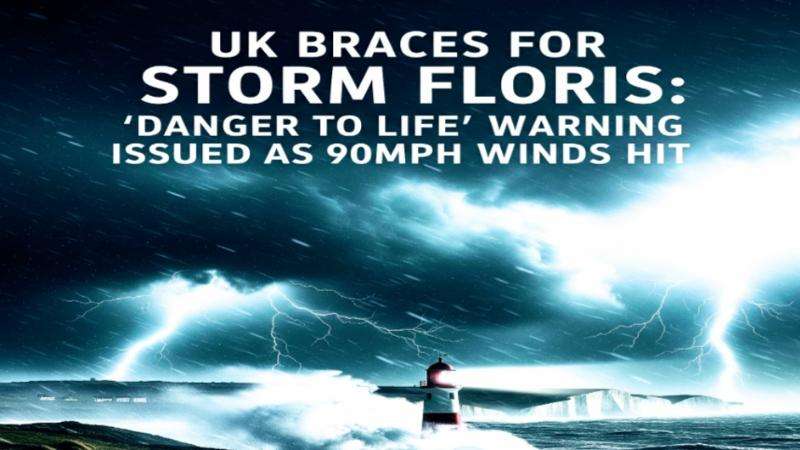Strong gusts and rain are threatening coastal areas and infrastructure, causing renewed weather mayhem.
Following Storm Éowyn's recent devastation, Storm Herminia has unleashed catastrophic weather conditions throughout the United Kingdom. The Spanish meteorological office dubbed this new storm to highlight the extraordinary weather patterns that are now affecting the area.
The impact of Storm Herminia became evident on January 26, with heavy rain and fierce winds beginning to batter parts of the UK, especially Cornwall. The Environment Agency issued 167 flood alerts and 27 flood warnings across England, reflecting the severity of the situation. Coastal areas faced enormous waves, creating hazardous conditions along seafronts, with some locations reporting approximately 80mm of rainfall anticipated.
According to the Met Office, powerful winds of up to 82mph whipped through the South West, leading to significant disruptions. Tom Morgan, a meteorologist at the Met Office, stated, "It’s also going to be wet and windy over the next few days in southern parts of the UK particularly". His warning underscored the potential for dangerous weather conditions as the storm advanced.
Transport services faced extensive interruptions due to fallen trees and flooding. Multiple train routes across Scotland were halted, as issues arose from earlier storms, which dismantled infrastructure and left tracks littered with debris. The ramifications were not limited to transportation; power outages affected over 100,000 customers across Northern Ireland alone, as utility companies scrambled to restore service.
Following the devastation of Storm Éowyn, which had already wrought havoc just days before, government officials held emergency COBRA meetings to coordinate recovery efforts. Michelle O’Neill, the First Minister of Northern Ireland, referred to the preceding storm as “unprecedented on every level,” emphasizing the extensive challenges posed by the dual storms. The recovery efforts were already strained, and the arrival of Storm Herminia prompted additional concern.
By late January 26, as Storm Herminia took center stage, local officials advised citizens to stay clear of coastal areas due to the formidable storm waves crashing ashore. The National Grid reported power disruptions affecting thousands of households, making the situation increasingly dire. Onlookers were treated to dramatic scenes of seawater overtaking promenades and flooding picturesque coastal towns.
Across Wales, similar weather warnings were issued for Pembrokeshire, Ceredigion, and Carmarthenshire. Residents anticipated severe weather conditions, bracing for gusts reaching up to 70 mph along exposed coastal regions. The Met Office confirmed the strong winds from Storm Herminia were scheduled to remain active until the evening of January 28.
On January 27, complications persisted as heavy rain advanced, with forecasts warning of additional rainfall and increased flooding risks. The environment agencies remained vigilant, notifying the public of possible surface flooding, which could lead to property damage.
John Swinney, the Scottish First Minister, echoed sentiments of concern as storms led to casualties. Following reports of fatalities from fallen trees during Storm Éowyn, he stated, "This is tragic and heartbreaking news. Our thoughts and sympathies are with the family and friends of the man who has died." The combined wrath of both storms signified the urgency for preparedness and vigilance as severe winter storms became increasingly frequent.
Looking forward, weather analysts expect the harsh conditions to persist throughout the early part of the week, with some forecasts improved slightly by midweek. Tom Morgan indicated the storm’s potential intensity wanes, stating, "It’s probably going to be less intense than Eowyn, but still hazardous with potential gusts of 60 to 70 mph in certain areas.”
This outlook still kept citizens and local authorities on high alert as conditions could rapidly change. With Storm Herminia's path, officials urged readiness for localized flooding and sustained wind impacts throughout affected counties. Long-term power restoration post-storm may take several days, particularly for those whose services were compromised by the earlier storms.
Indeed, both Storm Éowyn and Storm Herminia serve as reminders of the powerful and unpredictable nature of winter storms in the UK, putting infrastructure, utilities, and lives at risk. Residents are advised to remain cautious and informed as the weather evolves, illustrating the need for immediate and effective crisis response strategies.
For updates and safety announcements, it remains important for communities to stay connected with local news outlets and weather sources, ensuring they are prepared for any upcoming challenges posed by these weather systems.








.svg)

